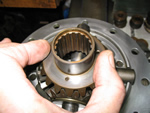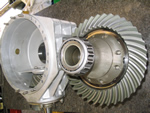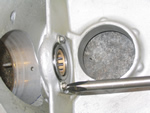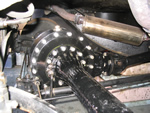





Removal of the old bearing
After removal of the half shaft from the axle it is necessary to mount the shaft in a lathe and turn down the bearing retaining collar until about 0.010 inch remains when it is easy to split and remove the remaining collar with a chisel, without damage to the shaft surface. It is important that the integrity of the shaft surface at this point is protected because eventually a new retaining collar will have to be pressed on to the shaft and it is only the interference fit between the collar and shaft plus the bearing fit, which retains the road wheel and bearing assembly. An alternative would be to use an angle grinder or cutter and remove the collar without damaging the shaft. Using a lathe does enable the straightness of the shaft to be checked. An out of truth shaft will wear both axle and wheel bearings and take its toll on the half shaft splines.
At this point it is necessary to mount the shaft in a hollow hydraulic press bed and provide a suitable support for the bearing housing whilst the shaft is pressed through, and therefore off the bearing. It is very important that the flange of the bearing housing, which is about 0.125 inch thick, is not used to support the housing during pressing operations. The bearing housing lower end must take the load and if any load is applied to the flange, distortion and subsequent water entry will result. There is also a very serious possibility of the flange breaking away at some time in the future.
By this time the wise owner will no doubt realise the wisdom of replacing these bearings whilst the car is in his / her own garage or with a specialist of their choice and that bearing renewal is not risking a distress purchase out on the open road.
| << Previous Page | Next Page >> |